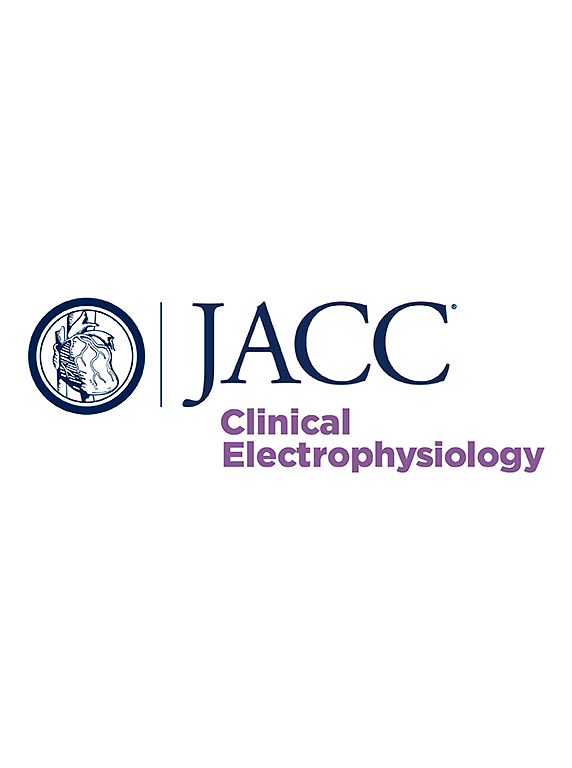非结构性心脏病患者伴有超快速心室反应的房性心动过速与猝死
IF 8
1区 医学
Q1 CARDIAC & CARDIOVASCULAR SYSTEMS
引用次数: 0
摘要
背景:心源性猝死(SCD)通常与危及生命的室性心律失常相关。室上性心律失常是沃尔夫-帕金森-怀特综合征和复杂先天性心脏病中SCD的公认原因。然而,心房性心动过速(ATAs)在心脏结构正常的SCD患者中的作用尚不清楚。目的:本研究的目的是提供无结构性心脏病(SHD)的复苏患者的数据,这些患者经历了反复的植入式心律转复除颤器(ICD)电击,这些患者具有共同的临床和电特征,表明ATAs可导致SCD。方法:我们描述了5例无SHD的年轻SCD幸存者以休克结束的晕厥事件的临床特征和ICD分析。还报道了引起晕厥发作的心律失常消融后的随访细节。结果:所有患者(男4例,女1例;中位年龄23岁;年龄范围15-47岁),表面心电图记录在复苏设置提示心室颤动。指数事件发生后,所有患者在肾上腺素能张力升高的情况下均表现出反复的心律失常晕厥发作,并接受ICD电击治疗。ICD提示心房颤动(4例心房颤动,1例心房心动过速)以接近300次/分的速度传导至心室,是导致晕厥事件的潜在心律失常。在中位随访34个月后,ATA消融消除了所有患者的心律失常晕厥和休克发作。随访期间无患者突然死亡。结论:共同的临床和电学特征定义了一种独特的由ATAs引起的SCD,在其他健康患者中具有超快速的心室反应。导管消融术是治疗此类患者的有效方法。本文章由计算机程序翻译,如有差异,请以英文原文为准。
Atrial Tachyarrhythmias With Ultra-Rapid Ventricular Response and Sudden Death in Patients Without Structural Heart Disease
Background
Sudden cardiac death (SCD) is generally associated with life-threatening ventricular arrhythmias. Supraventricular arrhythmias are an accepted cause of SCD in Wolff-Parkinson-White syndrome and complex congenital heart disease. However, the role of atrial tachyarrhythmias (ATAs) in SCD in patients with structurally normal hearts is unclear.
Objectives
The goal of this study was to present data on resuscitated patients without structural heart disease (SHD), experiencing recurrent implantable cardioverter-defibrillator (ICD) shocks, who share common clinical and electrical features suggesting that ATAs can cause SCD.
Methods
We describe the clinical characteristics and ICD analysis of syncopal events terminated with shock delivery in 5 young SCD survivors without SHD. Details on the follow-up after ablation of the arrhythmia causing the syncopal episode are also reported.
Results
In all patients (4 male, 1 female; median age 23 years; age range 15-47 years), a surface electrocardiogram recording in the resuscitation setting suggested ventricular fibrillation. After the index event, all patients exhibited recurrent arrhythmic syncopal episodes in a setting of elevated adrenergic tone, treated with ICD shocks. ICD interrogation suggested ATAs (atrial fibrillation in 4 patients, atrial tachycardia in 1 patient), conducting to the ventricles at rates approaching 300 beats/min, as the underlying arrhythmia leading to the syncopal events. ATA ablation abolished episodes of arrhythmic syncope and shock delivery in all patients after a median follow-up of 34 months. No patient died suddenly during follow-up.
Conclusions
Common clinical and electrical features define a distinct entity of SCD caused by ATAs with ultra-rapid ventricular response in otherwise healthy patients. Catheter ablation of the ATA is an effective treatment in these patients.
求助全文
通过发布文献求助,成功后即可免费获取论文全文。
去求助
来源期刊

JACC. Clinical electrophysiology
CARDIAC & CARDIOVASCULAR SYSTEMS-
CiteScore
10.30
自引率
5.70%
发文量
250
期刊介绍:
JACC: Clinical Electrophysiology is one of a family of specialist journals launched by the renowned Journal of the American College of Cardiology (JACC). It encompasses all aspects of the epidemiology, pathogenesis, diagnosis and treatment of cardiac arrhythmias. Submissions of original research and state-of-the-art reviews from cardiology, cardiovascular surgery, neurology, outcomes research, and related fields are encouraged. Experimental and preclinical work that directly relates to diagnostic or therapeutic interventions are also encouraged. In general, case reports will not be considered for publication.
 求助内容:
求助内容: 应助结果提醒方式:
应助结果提醒方式:


